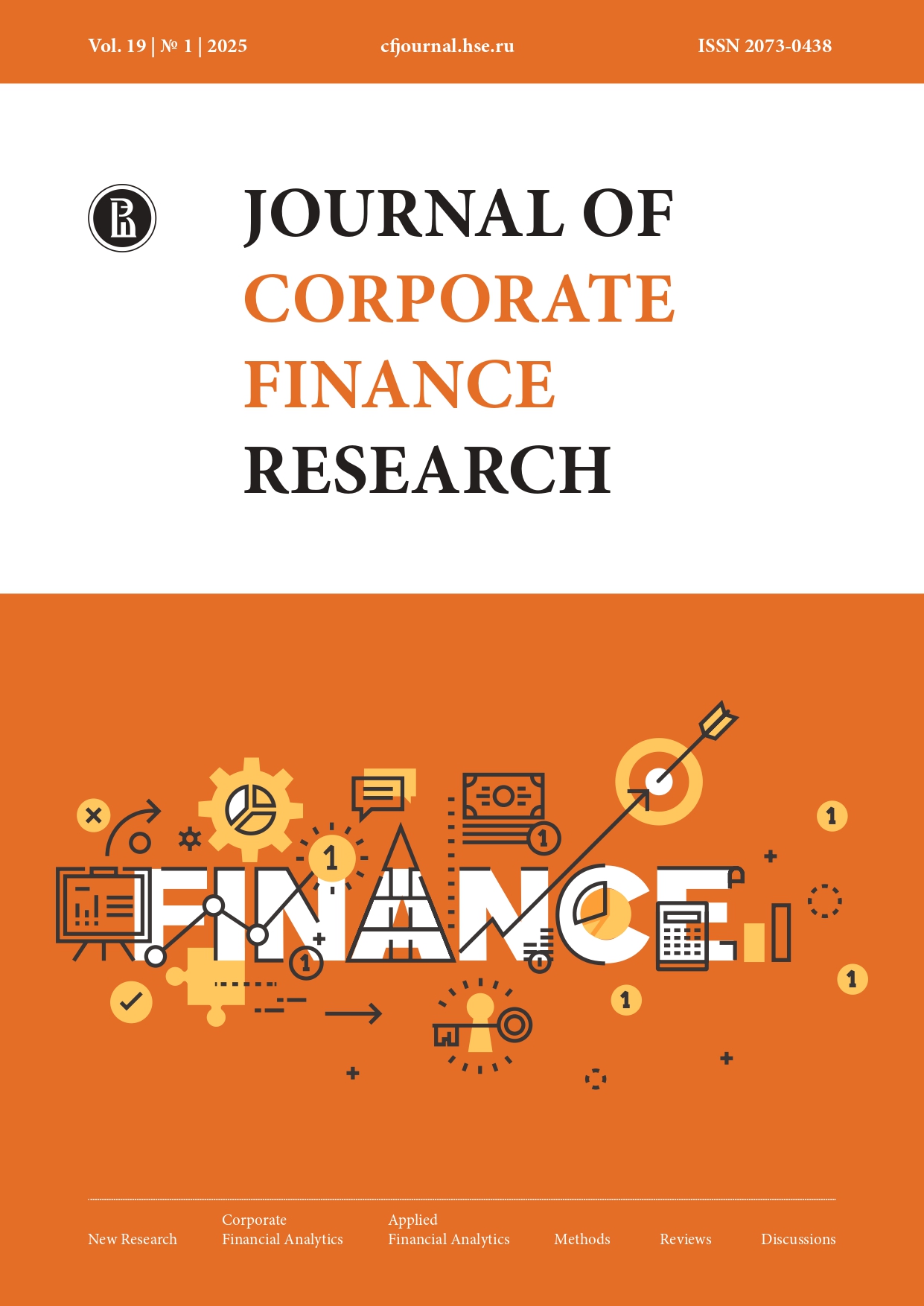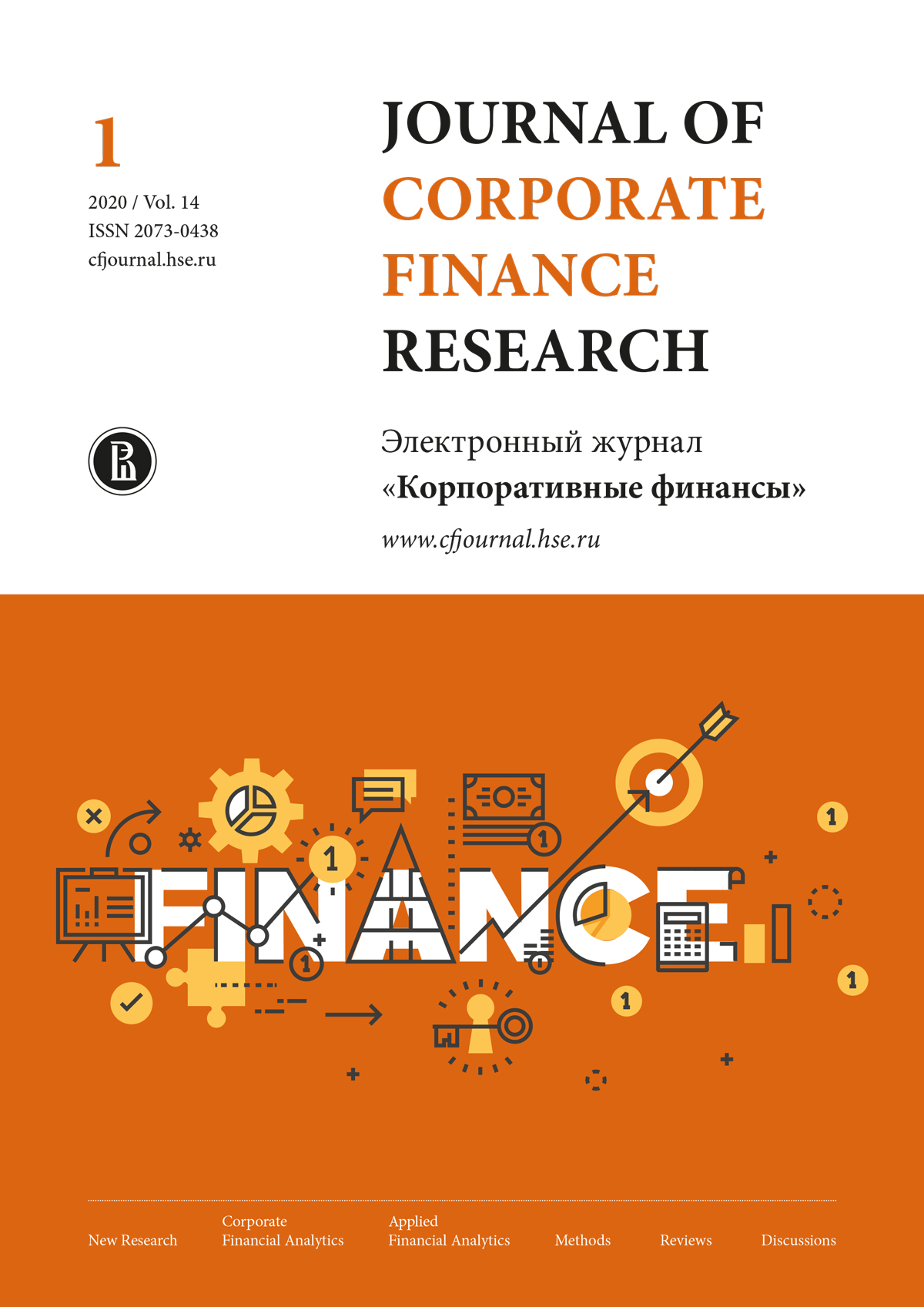The Impact of Domestic Mergers and Acquisitions on the Operating Profit Margins of Companies in Russia
- Авторы: Mikhalchuk V.1
-
Учреждения:
- Deloitte
- Выпуск: Том 14, № 1 (2020)
- Страницы: 69-79
- Раздел: Прикладная финансовая аналитика
- URL: https://journal-vniispk.ru/2073-0438/article/view/299662
- DOI: https://doi.org/10.17323/j.jcfr.2073-0438.14.1.2020.69-79
- ID: 299662
Цитировать
Полный текст
Аннотация
This research paper studies the impact of domestic Russian mergers and acquisitions on the operating profit margin of companies participating in deals. The goal of the research is to evaluate the changes in operating profit margin, and to analyse the significance of factors affecting operating profit margin after deals have been concluded.
The main scientific contribution of this research is the development of a methodology to analyse the effect of mergers and acquisitions on operating profit margins that takes into account the idiosyncratic features of the Russian market, and which can be used with limited information for analysis of private companies. The proposed methodology is based on benchmarking the operating profit margin of companies participating in a deal against the same variable for a portfolio of similar companies.
Based on the analysis of recent studies, several explanatory variables were proposed to explain the changes in operating profit margin after the deal. Among these were included real GDP growth, type and value of the deal, book value of assets of the target company, as well as a number of control variables. A random effects model with robust standard errors was used to test the significance of factors affecting operating profit margin. This methodology was applied to a sample of 73 domestic Russian deals observed in the period 2012-2019.
This research makes several practical contributions to the literature. In the studied sample, deals lead to an increase of operating profit margin by 4.6% relative to the period before the deal, and 2.5% relative to the benchmark portfolio. The highest growth of operating profit margin relative to the benchmark portfolio is observed 2 years after the deal. This growth is increased by the purchase of large companies in the same industry. There is a significant negative effect of the deal value and a strong indication that buyers tend to overpay for the target companies relative to their fair value.
This research will be of practical use for persons in management positions to estimate the value of prospective deals, and for academic researchers interested in the analysis of mergers and acquisitions in emerging markets.
Ключевые слова
Об авторах
V. Mikhalchuk
Deloitte
Автор, ответственный за переписку.
Email: vitalymikhalchuk@gmail.com
ORCID iD: 0000-0002-1899-685X
Research Supervisor
Россия,Список литературы
- Barber B., Lyon J. Detecting long-run abnormal stock returns: the empirical power and specification of test statistics. Journal of Financial Economics. 1997;43(3):341–372. doi: 10.1016/S0304-405X(96)00890-2.
- Moeller S., Schlingemann F. Wealth destruction on a massive scale? A study of acquiring‐firm returns in the recent merger wave. The Journal of Finance. 2005;60(2):757–782. doi: 10.1111/j.1540-6261.2005.00745.x.
- Kaplan S., Weisbach M. The success of acquisitions: evidence from divestitures. The Journal of Finance. 1992;47(1):107–138. doi: 10.1111/j.1540-6261.1992.tb03980.x.
- Healy P., Palepu K., Ruback R. Does corporate performance improve after mergers? Journal of Financial Economics. 1992;31(2):135–175. doi: 10.1016/0304-405X(92)90002-F.
- Golubov A., Nan X. Post-acquisition performance of private acquirers. Journal of Corporate Finance. 2020;60. doi: 10.1016/j.jcorpfin.2019.101545.
- Blonigen B., Pierce J. Evidence for the effects of mergers on market power and efficiency. National Bureau of Economic Research. 2016;w22750:1–36. URL: https://www.nber.org/papers/w22750.pdf.
- Kyriazopoulos G., Drymbetas E. Do domestic banks mergers and acquisitions still create value? Recent evidence from Europe. Journal of Finance and Bank Management. 2015;3(1):100–116. doi: 10.15640/jfbm.v3n1a10.
- Buzzell R., Gale B., Sultan R. Market share – a key to profitability. Harvard Business Review. 1975;53(1):97–106.
- Faria A., Wellington W. Validating business simulations: does high market share lead to high profitability? Developments in Business Simulation and Experiential Learning. 2014;31:332–336.
- Martin J., Voltes-Dorta A. International airports: economies of scale and marginal costs. Journal of the Transportation Research Forum. 2010;47(1):5–22. doi: 10.5399/osu/jtrf.47.1.1056.
- Beccalli E., Anolli M., Borello G. Are European banks too big? Evidence on economies of scale. Journal of Banking & Finance. 2015;58:232–246. doi: 10.1016/j.jbankfin.2015.04.014.
- Kuternin M. Production functions of the Russian economy sectors taking into account effect of economy at a scale. The State University of Management Journal. 2018;(3):90–97. (In Russian.) doi: 10.26425/1816-4277-2018-3-90-97.
- Reddy K., Nangia V., Agrawal R. The 2007–2008 global financial crisis, and cross-border mergers and acquisitions: a 26-nation exploratory study. Global Journal of Emerging Market Economies. 2014;6(3):16–29. doi: 10.1177/0974910114540720.
- Goddard J., Molyneux P., Zhou T. Bank mergers and acquisitions in emerging markets: evidence from Asia and Latin America. The European Journal of Finance. 2012;18(5):419–438. doi: 10.1080/1351847X.2011.601668.
- Ibrahimi M., Meghouar H. Sources of value creation and destruction in horizontal mergers and acquisitions. Managerial Finance. 2019;45(10–11):1398–1415. doi: 10.1108/MF-02-2018-0053.
- Chen Y., Lok C., Phua L., Quah K. The impact of mergers and acquisitions on financial performance of listed companies in China. International Journal of Entrepreneurship and Management Practices. 2019;8(2):01–12. doi: 10.35631/ijemp.28001.
- Grigorieva S., Trotsky P. Impact of mergers and acquisitions on the operational efficiency of companies in emerging capital markets. Journal of Corporate Finance Research. 2012;23(3):31–43. (In Russian.) doi: 10.17323/j.jcfr.2073-0438.6.3.2012.31-43.
- Agliardi E., Lukyanova I. Evidence from corporate mergers: leverage, industry characteristics and returns’ moments. Journal of Corporate Finance Research. 2012;5(4):54–76. (In Russian.) doi: 10.17323/j.jcfr.2073-0438.5.4.2011.54-76.
- Rogova E., Luzina D. The effect of mergers and acquisitions on companies’ fundamental values in emerging capital markets (the case of BRICS). Journal of Corporate Finance Research. 2015;9(3):27–50. (In Russian.) doi: 10.17323/j.jcfr.2073-0438.9.3.2015.27-50.
- Grigorieva S., Grinchenko A. Impact of mergers and acquisitions in financial sector on bidder’s returns in emerging capital markets. Journal of Corporate Finance Research. 2014;7(4):53–71. (In Russian.) doi: 10.17323/j.jcfr.2073-0438.7.4.2013.53-71.
- Rao-Nicholson R., Salaber J., Cao T. Long-term performance of mergers and acquisitions in ASEAN countries. Research in International Business and Finance. 2016;36:373–387. doi: 10.1016/j.ribaf.2015.09.024.
- Penas M., Unal H. Gains in bank mergers: evidence from the bond markets. Journal of Financial Economics. 2004;74(1):149–179. doi: 10.1016/j.jfineco.2003.05.004.
- Megginson W., Morgan A., Nail L. The determinants of positive long-term performance in strategic mergers: corporate focus and cash. Journal of Banking & Finance. 2004;28(3):532–533. doi: 10.1016/S0378-4266(02)00412-0.
- Gishan D., Drobetz W., Momtaz P. Competition policy and the profitability of corporate acquisitions. Journal of Corporate Finance. 2020;62. doi: 10.1016/j.jcorpfin.2019.101510.
- Wilcoxon F. Individual comparisons by ranking methods. Biometrics Bulletin. 1945;1(6):80–83. doi: 10.2307/3001968.
Дополнительные файлы











